Apple’s range of MacBooks that use the company’s own Silicon M1 or M2 processors cannot natively connect more than one external monitor, which is a massive limitation on the previous Intel-based generation of Mac laptops that could run two displays when connected to a USB-C or Thunderbolt 3 docking station or hub.
The M1 Pro and M1 Max do support multiple external displays, so owners of these Mac laptops can relax.
We hoped the M2 would lose the M1 limitation, but it survives on the plain M2; when available, expect the M2 Pro and M2 Max to support more displays, just like their M1 siblings.
M1 MacBook Air: Maximum one external display
M2 MacBook Air: Maximum one external display
M1 MacBook Pro: Maximum one external display
M1 Pro MacBook Pro: Maximum two external displays
M1 Max MacBook Pro: Maximum three external displays
However, there are ways around this plain M1/M2 limitation, allowing you to run two external displays off an M1/M2 MacBook, which we will outline here. There’s a software driver plus dock workaround and a hub/adapter workaround.
With the software workaround, there are some risks involved as you will be required to install third-party drivers, and these might later be unsupported by future updates of the macOS. And you will likely have to buy at least one adapter, where previously a dock plus a display cable per external screen would have sufficed.
The hardware solution involves a dual-HDMI adapter that requires a little tinkering in System Preferences at setup.
If you waited for Apple’s latest 14in or 16in M1 Pro M1 Max MacBook Pro models, you are in luck as these laptops do support multiple external displays. Laptops with the M1 Pro can connect to up to two external displays with up to 6K resolution at 60Hz, while MacBooks with the M1 Max can connect to three external displays with up to 6K resolution and one external display with up to 4K resolution at 60Hz.
M1/M2 owners, start saving for a new MacBook Pro or read on.
External displays: big problem for M1 and M2 Macs
Apple’s Mac mini, MacBook Air, and MacBook Pro 13in were the first Macs to feature the Apple-designed M1 CPU. They received rave reviews for their speed improvements over Intel-based laptops, including here on Macworld.
See our comparison of the 13in MacBook Pro (M1) vs MacBook Pro (Intel) and MacBook Air (M1 Silicon) vs MacBook Air (Intel). We have also looked at the differences between the Mac mini (M1) and Mac mini (Intel), and look at what we can expect from the new M2 Macs.
But if your MacBook setup includes running more than one external display, you have a major problem. Apple’s M1 or M2 chips simply won’t consider it—at least natively.
Apple states in the M1 and M2 MacBook Air and MacBook Pro tech specs that they support only “one external display with up to 6K resolution at 60Hz”.

Apple
While the M1 and M2 MacBooks natively support just one monitor, the M1 Mac Mini does natively support up to two external monitors—one via the HDMI port and a second via USB-C. But the M1 models of the MacBook Air and MacBook Pro support only one external display.
Apple has apparently promised to fix the problem in a future macOS update, but the arrival of the later M1 Pro and M1 Max—and more recently the M2—suggest that M1 owners could be waiting a long time. We have this guide to Monitors for M1 Macs and what you need to know before buying. We also cover the basics of how to connect your Mac to an external monitor.
Workaround #1: install DisplayLink software drivers
You can use a combination of display technologies to get around the M1/M2 MacBooks’ single-monitor limitation. This should work with most third-party docks, although some manufacturers, such as Caldigit, don’t recommend it.
For example, Plugable’s multi-display docks use a combination of native USB-C Alternate Mode (native “Alt Mode” video output) and DisplayLink technology. This combination serves as a workaround to the M1/M2 platform supporting only a single external display via USB-C.
Note that DisplayLink requires a third-party driver to be installed on the Mac. There are different versions of the DisplayLink driver, and some bring their own compromises to the party.
The DisplayLink macOS app or DisplayLink Manager app are ways of enabling DisplayLink technology on macOS. The app is available as a standalone installer rather than through the mac App Store.
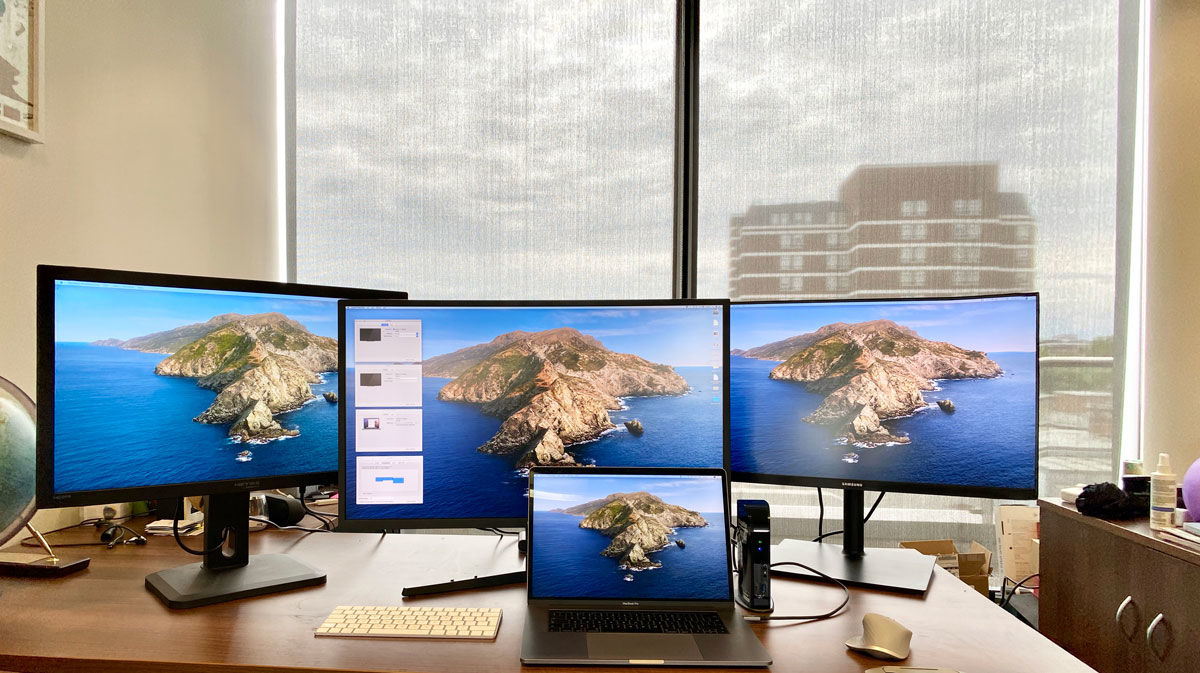
1. First, download the latest Mac DisplayLink driver.
DisplayLink Manager Graphics Connectivity App v. 1.7.0 is compatible with macOS Catalina 10.15, macOS 11 Big Sur and macOS 12 Monterey. It can be managed via the DisplayLink icon in the Apple Menu bar.
The macOS requires the user to permit “Screen Recording” in order for DisplayLink devices to work properly. This can be found in System Preferences under Privacy in Security & Privacy; navigate to Screen Recording in the list on the left, then tick the Screen Recording permission for DisplayLink Manager after unlocking the padlock using your admin password. You may need to quit and restart DisplayLink Manager afterwards.
More in-depth details on DisplayLink Manager under macOS Big Sur, Catalina and Monterey, in this DisplayLink support page.
Installation is straightforward. Older versions did not support laptops’ closed-display/Clamshell mode, but 1.7.0 does support Clamshell mode if the MacBook is Intel-based running macOS 12 or if the MacBook is M1-based running macOS 11 or 12.
Other limitations include incompatibility with display rotation. Rotation on Apple M1/M2 requires DisplayLink Manager 1.6+ with macOS 12+.
There’s an option in DisplayLink manager to “launch at startup”, or you can drag the DisplayLink Manager to your Login Items in Users & Groups.
2. Then connect the MacBook to a dock.
3. For the first screen you can connect via the dock’s DisplayPort or HDMI Port, and this will be handled natively by the M1/M2 MacBook.
You could also connect the first external display via the dock’s other display ports or via a Thunderbolt or USB-C to HDMI or DisplayPort adapter.
The HDMI or DisplayPort output uses Alternate Mode (Alt Mode), and as it is basically a pipeline directly to the system’s native GPU, it will behave just like if you hooked up a USB-C to HDMI dongle to your laptop. This requires no user driver installation.
The second and third displays will rely on the DisplayLink software. DisplayLink uses an installed driver and the system CPU and GPU to convert graphics data on the system into data packets. That data is then sent over the cable as data packets, and converted back to video information and output to the monitors via the DisplayLink chip in the docking station.
Workaround #2: install InstantView software
Another third-party software solution is SiliconMotion’s InstantView, which operates in a similar way to DisplayLink and works with two of the hardware hubs and adapters we review below.
The initial setup is easier than DisplayLink but it suffers the same challenge that Apple’s software updates can disable it, which will entail installing a newer version and allowing the necessary security & privacy settings for screen recording—just as with DisplayLink.
Neither is complicated and both worked well in our tests as you can read below.
Which docks support DisplayLink and InstantView?
Originally, dock manufacturers did not officially supported such a DisplayLink setup for Macs. The solution works, but they warned that this could become unstuck in future versions of the macOS. Whenever there is a new OS update the drivers may need to be updated each time.
However, after some recent testing and improvements Plugable, for example, has updated its compatibility to officially support that configuration. For Mac compatibility, it has validated both Apple and Intel platforms running at least macOS 11. For M2, the company does anticipate compatibility but is awaiting new M2 MacBooks for testing and validation.
Learn more about the best Thunderbolt docking stations for more details, or you can connect via a simpler USB-C hub. Look for a dock with two or more display ports, preferably ones that can connect to your preferred displays without the need for an adapter. Some, such as the Anker Apex, have two display ports but Anker warns against using it with Macs, even though DisplayLink should work around the problem.
Thunderbolt 4 docks or hubs often have no dedicated display port but three available TB4 ports that can be used to connect directly to a USB-C display or via adapters to HDMI or DisplayPort monitors. While you may have to buy an adapter cable, 40GBps Thunderbolt 4’s port flexibility and backwards compatibility are recommended for users of modern Macs such as the M1 and M2 MacBooks.
Docking station and hub manufacturers are now actively marketing their products as solutions to the M1/M2 external display limitation. Each requires either the DisplayLink download or another similar software solution, such as InstantView, but no further hardware adapter except for the dock or hub itself. And of course these hubs offer the usual multi-port benefits as well as the external monitor solution.

If your hub or dock has just one display port, you could also attach a second or third display via one or more of the spare USB-A ports, using an adapter such as StarTech.com USB 3.0 to HDMI / DVI Adapter. This costs £80 or US$80, so needs to be factored in when pricing an M1/M2 MacBook purchase if you require multiple monitors and want to use the USB-A port rather than a display port such as HDMI or DisplayPort. Another option is Plugable’s USB Dual 4K Display Adapter.
This adapter turns an available USB-A 3.0 port into one DVI-I or VGA port (DVI to VGA adapter included) and one HDMI output. Each display can simultaneously support the maximum resolution of 2048×1152 at 60Hz. Make sure to use an active HDMI DisplayLink adapter that can support 4K at 60Hz, as some are limited to 4K at 30H
The best multiscreen hubs and adapters for M1 and M2 MacBooks
Below we have gathered the best dedicated hubs and docks for multiscreen M1/M2. Note that these listed (and tested) below use USB-C rather than Thunderbolt, so don’t benefit from the MacBook’s potential 40Gbps data bandwidth. If you desite Thunderbolt, go for a Thunderbolt dock and install DisplayLink as instructed above.
Ugreen USB-C Triple Display Docking Station
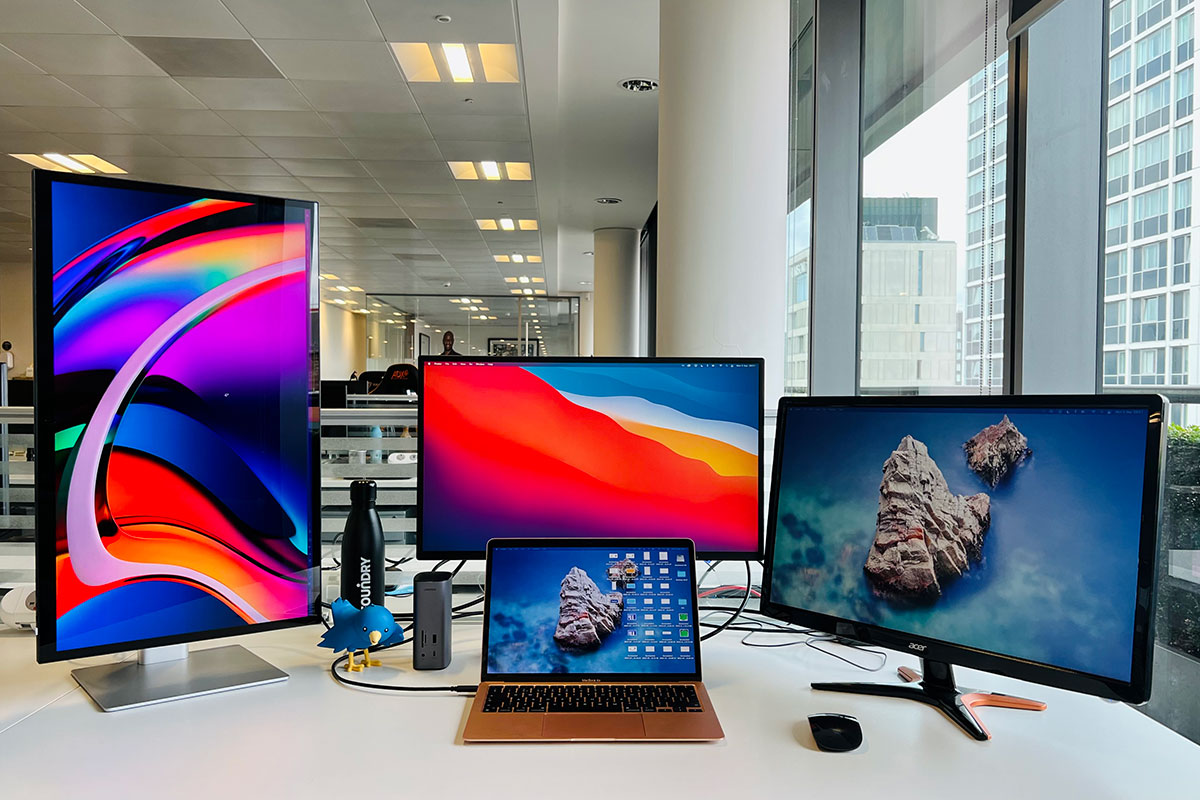
Pros
- Supports three external displays at 4K 60Hz
- 12 ports, inc. 10Gbps USB-C and USB-A
Cons
- Requires USB-C charger
The Ugreen USB-C Triple Display Docking Station is a quality compact vertical dock supports up to three external displays on a plain (non-Pro or -Max) M1/M2 MacBook if you install DisplayLink software.
Priced at $329/£369, it features two HDMI ports and a DisplayPort and can support three 4K displays at 60Hz on a Mac. There are 12 ports in total, including Gigabit Ethernet, card readers and 10Gbps USB-A and USB-C ports. It connects to the MacBook via 10Gbps USB-C.
You need to install DisplayLink on your Mac—instructions above. Ugreen could make this easier with a link on its site.
Hyperdrive Dual 4K HDMI 10-in-1 USB-C Hub
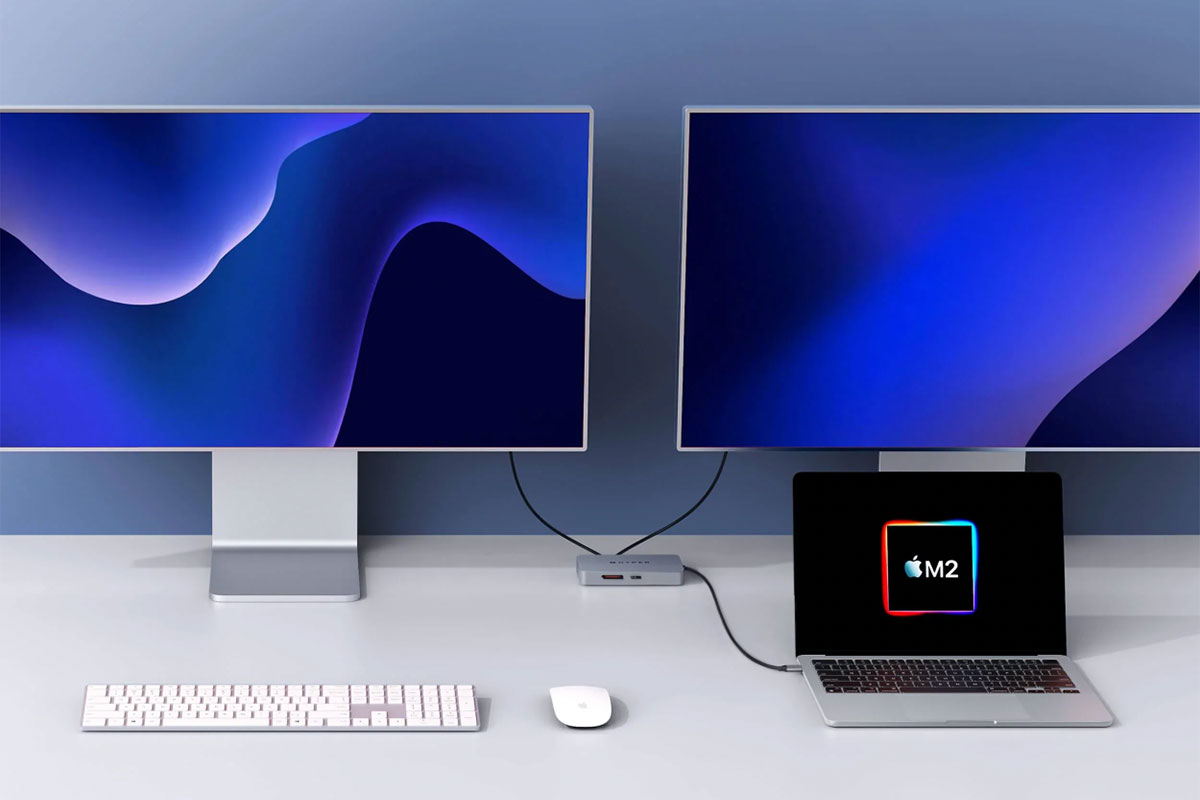
Pros
- Supports two external displays at 4K
- 10 ports, inc. 5Gbps USB-C and USB-A
- InstantView easier than DisplayLink
Cons
- Second 4K display is 30Hz rather than 60Hz
- Requires USB-C charger
The Hyperdrive Dual 4K HDMI 10-in-1 USB-C Hub doesn’t use DisplayLink and instead uses SiliconMotion’s InstantView.
Hyper says that it works “without having to download cumbersome drivers” but there is some software installation involved, and you need to allow InstantView access to your Privacy settings in System Preferences. You connect the hub or adapter to your M1 MacBook and find the HyperDisplay app that appears in a Finder folder sidebar. Double-click the macOS InstantView icon and follow the System Preferences instructions. Once this has been completed your MacBook will automatically recognize the adapter from then on.
It’s an easier solution than DisplayLink but with the same ability to allow M1 and M2 Macs to connect to multiple external displays.
This compact hub still includes 10 ports, including the all-important 2x HDMI. The first display at 60Hz is added via HDMI and DP Alt-mode and the second at 4K 30Hz through HDMI and InstantView.
Also included are Gigabit Ethernet, MicroUSB card reader (UHS-I), 3.5mm audio jack, 2x 5Gbps USB-A and one 5Gbps USB-C.
A further USB-C PD port allows you to charge the connected laptop at up to 100W—handy as the hub itself uses up one of your M1 or M2 laptop’s two Thunderbolt ports.
Hyperdrive Dual 4K HDMI Adapter
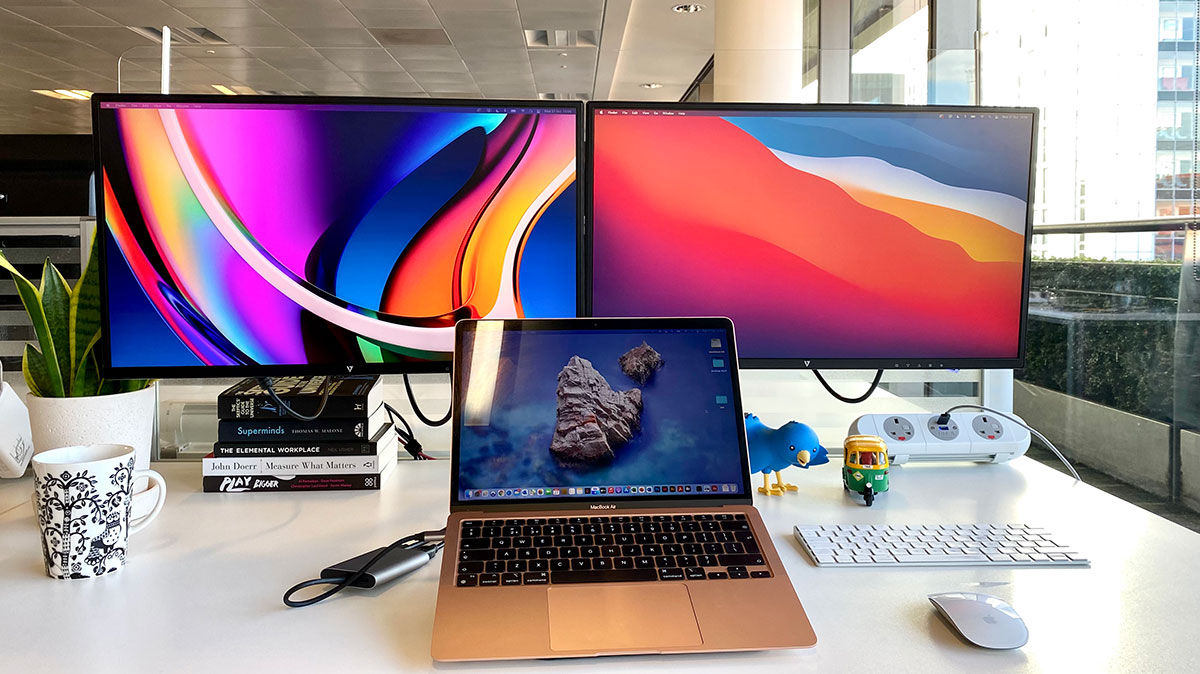
Pros
- Supports two external displays at 4K
- InstantView easier than DisplayLink
Cons
- Second 4K display is 30Hz rather than 60Hz
- No other ports except passthrough charging
- Requires USB-C charger
Like the Hyperdrive Dual 4K HDMI 10-in-1 USB-C Hub, Hyper’s cheaper Dual 4K HDMI Adapter uses the simpler InstantView software rather than DisplayLink.
Lacking any other ports, it’s not a hub and so just facilitates the dual-display function on M1 and M2 Macs. While it’s cheaper than its 10-port sibling, we’d recommend the more able hub—unless you need three displays, in which case you’d need to look at the other hubs and docks reviewed here.
One HDMI port supports 4K displays at 60Hz, but the other at the slower 30Hz.
A passthrough USB-C port requires a USB-C charger but can supply 100W to the connected laptop.
If you’re based outside the US, beware as Hyper charges $80 international shipping, making this adapter more expensive than its 10-port sibling.
Alogic Dual 4K Universal Compact Docking Station
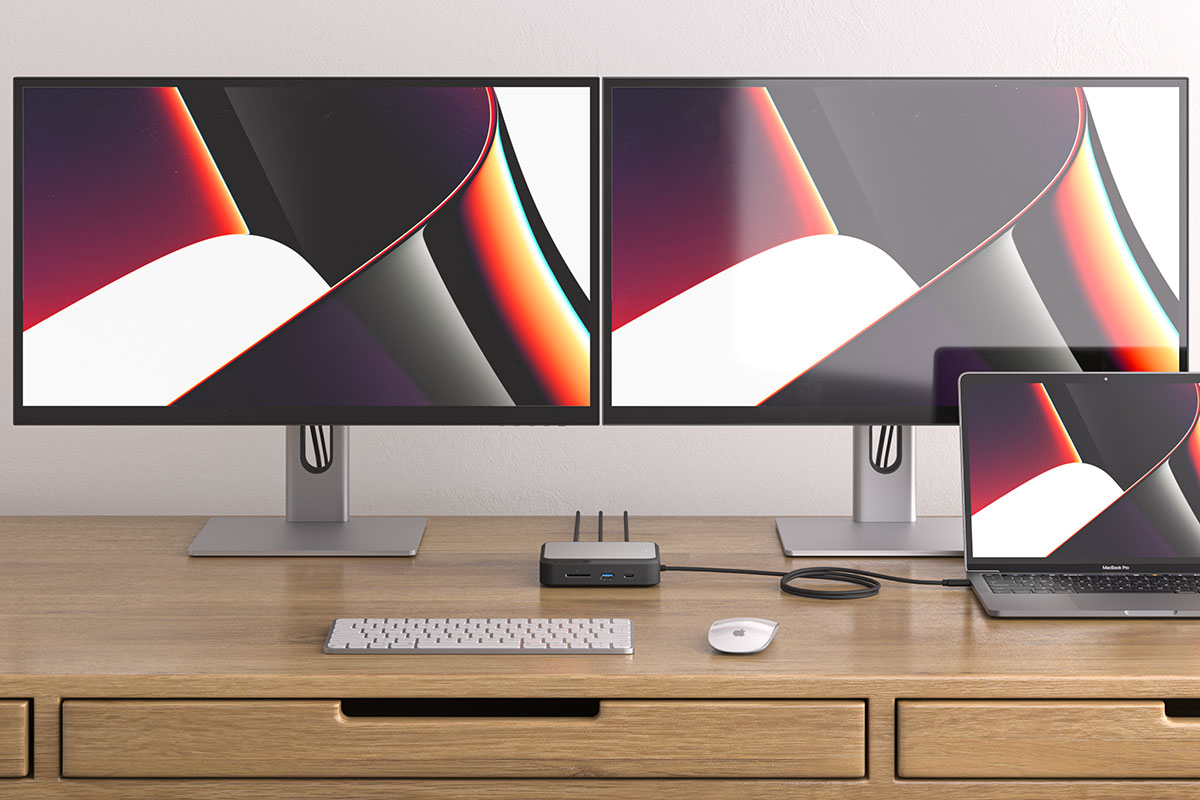
Pros
- Supports two external displays at 4K 60Hz
- 7 ports, inc. 10Gbps USB-C and USB-A
- HDMI and DisplayPort versions
Cons
- Requires USB-C charger
The Alogic Dual 4K Universal Compact Docking Station comes in two models—the CH2, which features two HDMI 2.0 ports; and the CD2, with two DisplayPort ports—so you can choose which best suits the external displays you already own.
Two external screens are probably enough for most people. If you require three, see the other hubs and docks reviewed here. Both screens can be up to 4K at 60Hz. Basic instructions are given on installing the DisplayLink software for M1 and M2 Macs.
This neat, compact dock doesn’t feature as many ports as others mentioned here but what it has are top-rated: both the USB-A and USB-C ports support 10Gbps data transfer. There is also a Gigabit Ethernet port and a UHS-II SD card reader.
A passthrough USB-C port—you need to add a suitably powerful charger—can handle 100W, although 22W is required by the dock so leaving 78W for laptop and device charging. The dock must be connected to the laptop to allow device charging.
EZQuest Ultimate Plus USB-C Multimedia Hub
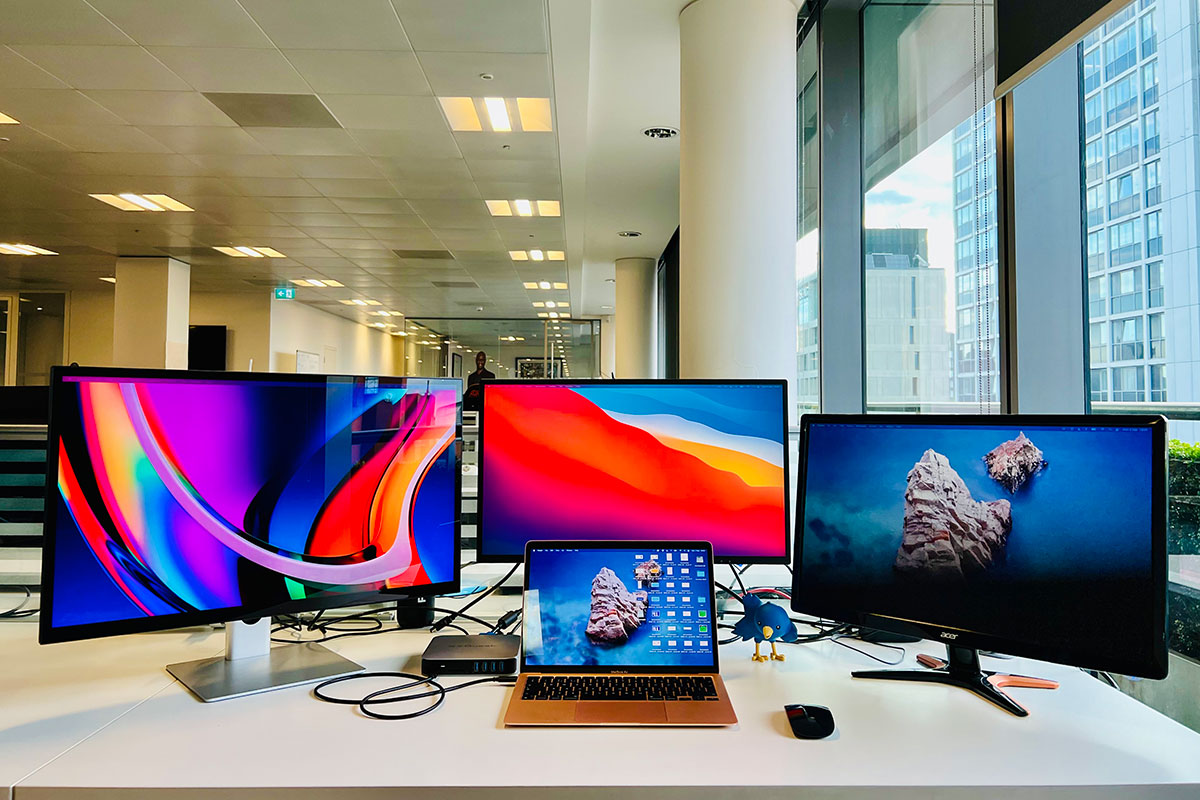
Pros
- Supports three external displays (2x 4K; 1x HD)
- VGA if you need it
- 12 ports, inc 4x 5Gbps USB-A
Cons
- Requires USB-C charger
- Second 4K display is 30Hz rather than 60Hz
- Third display is HD not 4K
The EZQuest Ultimate Plus USB-C Multimedia Hub has two HDMI ports and a VGA port, and supports one 4K at 60Hz and one 4K at 30Hz via HDMI and 1080p HD via VGA. If you want three 4K displays, look instead at the Ugreen Triple Display Dock.
It also features 5Gbps USB-A ports, Gigabit Ethernet and card readers.
Like the Ugreen dock, it requires a USB-C charger for power and can pass through up to 85W to the connected MacBook, but connects via slower 5Gbps USB-C.
Baseus 17-in-1 Docking Station
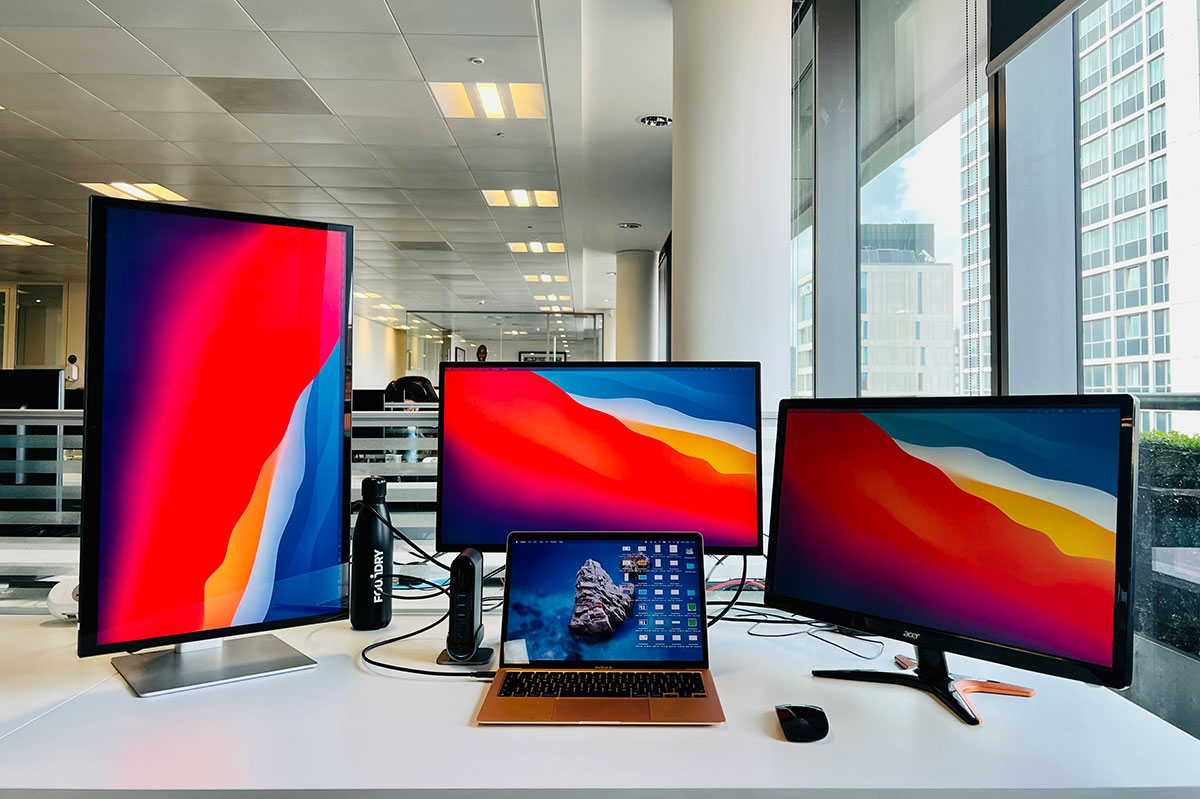
Pros
- Supports three external displays at 4K 30Hz
- 15 (actual) ports
- 85W PD
Cons
- Requires USB-C charger for laptop
- 30Hz 4K not 60Hz
The Baseus 17-in-1 Docking Station has three HDMI ports, each of which can connect to an external 4K display at 30Hz. If you require three 4K external displays at 60Hz, the Ugreen Triple Display Dock will fulfill your needs better. If 30Hz is fine, the Baseus will save you money. 60Hz is better for gamers as it offers smoother video.
Its claim to have 17 ports is exaggerated slightly as one is for the external power supply that powers just the dock at 12W. and another to add power the dock via a USB-C charger and then onto the laptop. But it has 15 other ports including the upstream 5Gbps USB-C connection to the MacBook, plus Gigabit Ethernet, card readers and 5Gbps USB-A and USB-C ports.
Workaround caveats
Whenever there is a new OS update DisplayLink and InstantView drivers may need to be updated each time.
Plugable doesn’t recommend the workaround for gaming, video editing, digital audio workstations (DAWs), and protected-content (HDCP) playback. For these workloads, users will want the full throughput of a “bare-metal” native GPU connection—such as provided by the DisplayPort or HDMI port on the dock using Alt Mode.
Caldigit actively recommends against using DisplayLink, as it finds it unreliable and there would be no synergy between the driver and the dock. Because it requires a third-party driver, users are at the mercy of Apple and the third-party developer to support later versions, the company told Macworld.
However, this combination of display technologies does allow M1 and M2 MacBooks to run more than one external monitor, and the M1 Mac mini to run more than two. And more manufactuers are coming out with docks and hubs that support it.
The only risk is that it could stop working at any time, although it wouldn’t harm your system if it did, and you could simply uninstall DisplayLink.
DIsplayLink and InstantView are workarounds with a potentially limited timespan but the likelihood is that compatibility would be restored at some stage if the worst happened and you would get back your multi-monitor setup.
The Hyperdrive dual 4K HDMI hardware solution is the more expensive but stable workaround of the two—but if you want up to three displays you’ll need a dock such as one of those reviewed above and the DisplayLink solution.
Read our M1 MacBook Air review and everything you need to know about the M2 MacBook Pro and M2 MacBook Air.
If you are wanting to use a second display with your Mac and not have your Mac’s screen on, read our feature How to turn a Mac’s screen off.
Read More
Title: How to connect two or more external displays to Apple Silicon M1 or M2 Macs
Sourced From: www.macworld.com/article/675869/how-to-connect-two-or-more-external-displays-to-apple-silicon-m1-macs.html
Published Date: Fri, 11 Nov 2022 14:30:00 +0000
.png)





